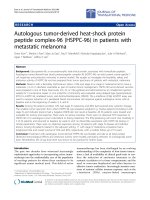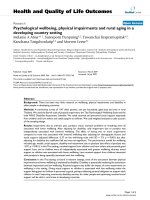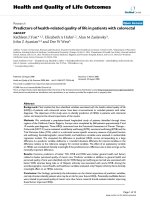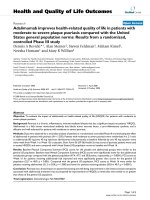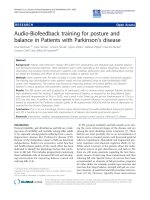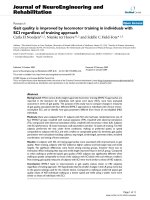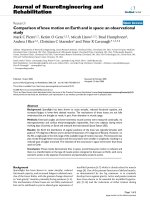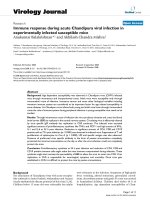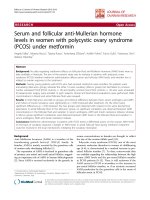Báo cáo hóa học: " Autologous tumor-derived heat-shock protein peptide complex-96 (HSPPC-96) in patients with metastatic melanoma" potx
Bạn đang xem bản rút gọn của tài liệu. Xem và tải ngay bản đầy đủ của tài liệu tại đây (373.59 KB, 13 trang )
RESEARC H Open Access
Autologous tumor-derived heat-shock protein
peptide complex-96 (HSPPC-96) in patients with
metastatic melanoma
Omar Eton
1*
, Merrick I Ross
2
, Mary Jo East
1
, Paul F Mansfield
2
, Nicholas Papadopoulos
1
, Julie A Ellerhorst
3
,
Agop Y Bedikian
1
, Jeffrey E Lee
2
Abstract
Background: Glycoprotein-96, a non-polymorphic heat-shock protein, associates with intracellular peptides.
Autologous tumor-derived heat shock protein-peptide complex 96 (HSPPC-96) can elicit potent tumor-specific T
cell responses and protective immunity in animal models. We sought to investigate the feasibility, safety, and
antitumor activity of HSPPC-96 vaccines prepared from tumor specimens of patients with metastatic melanoma.
Methods: Patients with a Karnofsky Performance Status >70% and stage III or stage IV melanoma had to hav e a
metastasis >3 cm in diameter resectable as part of routine clinical management. HSPPC-96 tumor-derived vaccines
were prepared in one of three dose levels (2.5, 25, or 100 μg/dose) and administered as an intradermal injection
weekly for 4 consecutive weeks. In vivo induction of immunity was evaluated using delayed-type hypersensitivity
(DTH) to HSPPC-96, irradiated tumor, and dinitrochlorobenzene (DNCB). The g-interferon (IFNg) ELISPOT assay was
used to measure induction of a peripheral blood mononuclear cell response against autologous tumor cells at
baseline and at the beginning of weeks 3, 4, and 8.
Results: Among 36 patients enrolled, 72% had stage IV melanoma and 83% had received prior systemic therapy.
The smallest tumor specimen from which HSPPC-96 was prepared weighed 2 g. Twelve patients (including 9 with
stage IV and indicator lesions) had a negative DNCB skin test result at baseline. All 36 patients were treated and
evaluable for toxicity and response. There were no serious toxicities. There were no observed DTH responses to
HSPPC-96 or to autologous tumor cells before or during treatment. The IFNg-producing cell count rose modestly in
5 of 26 patients and returned to baseline by week 8, with no discernible association with HSPPC-96 dosing or
clinical parameters. There were no objective responses among 16 patients with stage IV disease and indicator
lesions. Among 20 patients treated in the adjuvant setting, 11 with stage IV melanoma at baseline had a
progression-free and overall survival of 45% and 82%, respectively, with a median follow-up of 10 years.
Conclusion: Treatment with autologous tumor-derived HSPPC-96 was feasible and safe at all dose s tested.
Observed immunological effects and antitumor activity were modest, precluding selection of a biologically active
dose. Nevertheless, the 25-μg dose level was shown to be practical for further study.
Introduction
The past two decades have witnessed increasingly
sophisticated approaches to incorporating active immu-
notherapy into the multimodalit y care of the po pulation
of oncology patients for whom there continues to be
significant unmet medical need. This field of active
immunotherapy has been challenged by an evolving
understanding of the complexity of h ost-tumor interac-
tions, a lack of a vailability of clinical grade tests to con-
firm the induction of antitumor immunity in the
systemic circulation or in tissue compartments, and the
need to overco me biophysical and other barriers to
effective tumor eradication. Increasingly sensitive mea-
sures of systemic cellular immune response, such as the
g-interferon (IFNg) enzyme-linked immunospot
* Correspondence:
1
Department of Melanoma Medical Oncology, , The University of Texas MD
Anderson Cancer Center, 1515 Holcombe Boulevard, Houston, Texas, USA
Eton et al. Journal of Translational Medicine 2010, 8:9
/>© 2010 Eton et al; licensee BioMed Central Ltd. This is an Open Access article distributed under the terms of the Creative Commons
Attribution License ( which permits unrestricted use, distribution, and reproduction in
any medium, provided the original work is properly cited.
(ELISPOT) and tetramer assays, may facilitate the early
clinical development of cancer vaccines.
Gp96 is a non-polymorphic constitutively expressed
and inducible heat-shock protein (HSP) which associates
with intracellular antigenic peptides. Such gp96-peptide
complexes have been shown to elicit potent tumor-spe-
cific T cell responses and protective immunity in a vari-
ety of animal models. For example, immunotherapy of
mice with preexisting cancer ( includi ng spontaneously
derived B16 melanoma) treated with HSP preparations
derived from syngeneic cancer resulted in a delay of
progression of the primar y cancer, a reduced metastatic
load, and prolongation of life span, whereas treatment
with HSP preparations derived from cancers other than
the syngeneic cancer did not pr ovide such protection
[1,2]. These studies were especially interesting in that
they showed an autologous antitumor response without
identifying the specific tumor antigenic epitopes [1].
Furthermore, HSP-96 peptide complex (HSPPC-96;
Vitespen, formerly Oncophage) was shown to elicit anti-
gen-specific cytotoxic T lymphocytes (CTLs), w hereas
gp96 alone, peptide alone, or Freund’sadjuvantwith
peptide did not elicit such antigen-specific CTLs [2].
Srivastava et al. proposed a peptide relay model to
explain these findings wherein HSPs shuttle peptides
from the proteosome to the endoplasmic reticulum; in
the end oplasmic reticulum, immunogenic peptides
bound t o HSP-96 may transfer to the major histocom-
patibility complex (MHC). Supporting this model, HSP-
96 and MHC have homology in the peptide-binding
domains [3].
Many peptides being evaluated in melanoma immu-
notherapy trials are restricted in binding to a specific
human MHC haplotype (human leukocyte antigen
[HLA].) for presentation on the cell surface. However,
gp96 is non-polymorphic; thus, gp96-derived vaccines
could p otentially have broader applicability than HLA-
restricted peptide vaccines. Immunizing mice of the H-
2
b
haplotype with HSPPC-96 from SV40-transformed
cells of the H-2k haplotype resulted in an H -2b-
restricted antigen-specific CTL response [3]. Suto and
Srivastava demonstrated that exogenous viral peptides
chaperoned by gp96 could b e channeled into the endo-
genous pathway of specialized macrophages and pre-
sented through MHC class I molecules, resulting in
CD8+ CTL activation [4] . These findings supported a
structural basis for cross-priming: specialized profes-
sional antigen-presenti ng cells (APCs; e.g., macrophages
and dendritic cells) from the immunized mice could sal-
vage HSPPC-96 from damaged cells and present it in
the context of MHC class I mo lecules, ultimately result-
ing in an endogenous CTL immune response. In sup-
port of this idea, CD91 was identified as the HSPPC-96
receptor on these APCs [5]. Thus, treatment with
tumor-derived HSPPC-96 presumably could provide an
array of autologous tumor-specific peptide targets (and
even targets from endothelial and other cells in the
metastases) for CTL activation, all without the need to
characterize each peptide or exclude patients on the
basis of HLA phenotype.
Toxicology studies in mice treated with multiple doses
(0-100 ng) of HSPPC-96 over the course of either 2 or 4
weeks revealed no adverse consequences on body weight
or general health. Lymphoid hyperplasia was noted in
some mice. Notably, metastases in the treated mice
were smaller than those in control tumor-bearing mice,
and survival was longer [1]. One limitation of transition-
ing this treatment to patients was that it was unknown
whether sufficient HSPPC-96 could be purified from
resected metastases t o provide adequate doses. Another
limitation was the challenge of collecting, preparing,
standardizing, and certifying biologic material for treat-
men t der ived from individual patients’ tumors. Further-
more, at the time this study was conducted, HSPPC-96
had been shown to be stable for only up to 2 months
from the time of preparation, precluding treatment for
longer periods. HSPPC-96 has since been shown to be
stable for longer periods [6].
HSPPC-96 was first evaluated in humans in a small
trial in Germany in advanced cancer patients. Janetzki et
al showed that immunization with 25 μgofHSPPC-96
eli cited MHC Class I-restricted, tumor-specifi c CD8+ T
lymphocytes in 6 of 12 patients with advanced cancer
using the IFNg ELISPOT assay [7]. To determi ne the
utility of HSPPC-96 as a treatment for melanoma, we
undertook the first feasibility trial in the United States
in 1997. The goals of this study were to (1) evaluate the
feasibility of vaccine preparation, (2) determine the
safety and tolerance of 2.5, 25 or 100 μg/dose of
HSPPC-96 administered by the intradermal route weekly
for 4 weeks, (3) detect induction of a t umor-specific
immune response against autologous tumor, and (4)
document any observed antitumor activity. The three
dose levels were chosen empirically based on the pre-
dicted yield from a minimum of 2 g of tumor. The sche-
dule was limited to only 4 injections ov er 4 weeks.
Detecting t he induction of a cellular immune response
against autologous tumor in a reproducible manner
would provide justification for the clinical development
of HSPPC-96 as an anticancer agent.
Methods
Patients
Patients evaluated at M.D. Anderson were required to
have clinically confirmed advanced regional (nodal or
in-transit) melanoma ( stage III) or distant metastases
(stage IV) and Karnofsky Performance Status scores
>70%. Prior systemic treatment with chemotherapy
Eton et al. Journal of Translational Medicine 2010, 8:9
/>Page 2 of 13
drugs or cytokines was permissible . Patients undergoing
resection of large (>3 cm) histologically confirmed meta-
static melanoma as part of their routine clinical manage-
ment and who agreed to participate in the study signed
an Institutional Review Board (IRB)-approved consent
form for pro curement of tissue for autologous tumor-
derived HSPPC-96 preparation. T he resected metastasis
needed to yield ≥ 5 g of non-necrotic tumor so that we
could perfor m routine clinical pathologic study, vaccine
preparation, and treatment-related bioassays. Four
weeks after tumor resection, t he patients had to be fully
recovered from surgery and to demonstrate a <25%
increase in known visceral metastases and no appear-
ance of new metastases in liver, b one, or brain on fol-
low-up staging procedures. Patients were then required
to sign a second IRB-approved consent form for
HSPPC-96 treatment.
Ineligibility criteria included: pregnancy; severe inter-
current illness; routine use of steroids, non-steroidal
anti-inflammatory agents, or H2 antagonists; granulocyte
count < 1,500/mm
3
, platelet count <90,000/mm
3
;serum
creatinine level >1.5 mg/dl; or bilirubin level >1.2 mg/dl.
All indicator lesions were documented using physical
examination, computed tomography, magnetic reso-
nance imaging, and, for skin lesions, photography just
before informed consent was signed for treatment.
Patients underwent b aseli ne black-light examinations to
detect the presence of vitiligo.
Patients recorded sympto ms in a patient diary, and
adverse effects were monitored weekly and graded using
World Health Organization (WHO) criteria [8]. A physi-
cal examination was performed at weeks 4 and 8.
Patients with any vision complaints were referred to an
ophthalmologist for evaluation. Subsequently, history,
physical examination, and laboratory and radiologic test-
ing were performed every 6-8 weeks until evidence of
progressivediseaseorforthefirst6months.After6
months, the formal staging interval reverted to current
practice guidelines and was dependent on stage and
extent of disease. Objective tumor responses were evalu-
ated using WHO criteria [8].
Tumor Procurement and Initial Processing
A protocol specialist assisted the surgical pathologist in
dissecting tumor specimens immediately on delivery
from the operating room in a sterile wrap on ice. After a
small tumor specimen was set aside for clinical patholo-
gical review, the bulk of each tumor specimen (minimum
of 2 g of fresh non-necrotic tumor tissue) was used for
vaccine preparation and was dissected, placed into a
labeled 50-ml pyrogen-free vial in a plastic zip-lock bag
on dry ice, and sent in a polystyrene box with a tempera-
ture monitor by overnight air delivery to the Antigenics
Inc. vaccine preparation facility in Framingham, MA. In
exceptional cases, samples procured after hour s, on holi -
day, or over the weekend were stored in a -70°C freezer,
to be held for shipping on the next business day. Residual
non-necrotic tumor ( minimum 1-2 g) was processed
immediately on site for in vivo human delayed-type
hypersensi tivity (DTH) assays and for specialized in vitro
immunologic assays (see below).
Autologous Tumor-Derived HSPPC-96 Preparation
Details of HSPPC-96 preparation are available elsewhere
[6,9]. Briefly, at the Current Good Manufacturing Prac-
tice (CGMP) certified facility in Framingham, MA, the
tumor specimens we re thawed, minced, suspended in
sodium bicarbonate (pH 7.0), and homogenized. The
homogenate was centrifuged and protein from the super-
natant was selectively precipitated by a two-step ammo-
nium sulfate precipitation at 50% and 80% saturation
levels, f ollowed by affinity chromatography on Con-A
Sepharose a nd ion-exchange chromatography using a
Diethylamino Ethanol (DEAE) column. HSPPC-96 was
eluted and tested for purity, homogeneity, and identity by
SDS-PAGE and Western blotting. Buf fer exchange was
performed to isotonic saline, and the vaccine was sterile
filtered, aliquoted, and stored at -80°C. The concentra-
tion of each individual’sHSPPC-96wasgivenasmicro-
gram per milliliter. The release criteria for each patient’s
vaccine included: 1) ≥ 50% 96-kDa band by SDS-PAGE
gel; 2) sterility by USP sterility test; 3) minimal endotoxin
content by Limulus amoebocyte assay. The dose level for
each patien t was determined by the amount of vacci ne
material available for four equal aliquots of 2.5, 25, or
100 μg each. The full vaccine series for each patient was
returned by overnight mail in four individual vials on dry
ice to the M. D. Anderson Investigational Drug Phar-
macy, where the vials were stored in a -70°C freezer until
the patient was ready for treatment.
Autologous Tumor-Derived HSPPC-96 Administration
In the Melanoma Medical Oncology Clinic at M. D.
Anderson, a vial of HSPPC-96 was thawed and the con-
tents drawn up into a tuberculin syringe and injected
intradermally into either the patient’s anterior deltoid,
medial subinguinal, or subcl avicular region. Areas distal
to surgically affected lymph node basins were avoided.
Ten patients were to be treated at each of three dose
levels of HSPPC-96 (2.5, 25, or 100 μg). Treatment was
administered weekly for 4 consecutive weeks. Patients
could be retreated with HSPPC-96 from a second har-
vested tumor.
Immunological Monitoring
Skin Testing
Prior to weekly vaccines 1 (baseline) and 4 (beginning
of week 4) and at the first month follow-up visit after
Eton et al. Journal of Translational Medicine 2010, 8:9
/>Page 3 of 13
dose 4 (week 8), the research laboratory provided two
insulin syringes for DTH control assays using intra-
dermal injection on the volar surface of the forearms.
One syringe contained confirmed sterile 10
5
mechani-
cally dissociated X-irradiated (20 Gy) autologous
tumor cells from the or iginal surgical specimen cryo-
preserved in 10% dimethylsulfoxide and 10% human
albumin in saline. The other syringe contained 10
5
X-
irradiated autologous peripheral blood leukocytes ser-
ving as a negative control, cryopreserved in a similar
manner.
Because the treatment route for HSPPC-96 was in the
skin, delayed cutaneous hypersensitivity to 2,4-dinitro-
chlo robenzene (DNCB) was used to test de novo immu-
nity to this chemical, based on assays developed and
tested in cancer and melanoma patients since the 1960s
[11,12]. After cleaning the skin with acetone, 2000 and
50 μgofDNCBin100μl of acetone were layered on
the skin of the volar aspect of the forearm, and each
dose was confined by a ring with 2 cm inner diameter.
After drying with portable hair dryer, each site was cov-
ered with a bandage for 24 hours, resulting in an erythe-
matous reaction that cleared in a few days. Between 9
and 21 days, induration at b oth sites c onfirmed a grade
4 DTH response and induration at the 2000 μg site only
indicated a grade 3 DTH response. With no response at
either site, retesting with 50 μg, yielding a >5 mm
induration after 48 hours confirmed a grade 2 DTH
response. No effort was made to distinguish a grade 1
from a grade 0 response, because this would have
required a skin biopsy [10-12].
Peripheral Blood Mononuclear Cell (PBMC) Assays
For PBMC assay, 40 ml of peripheral blood was col-
lected into heparinized Vacutainer tubes prior to the
first, third, and fourth treatment with HSPPC-96 and at
the 8-week follow-up visit. PBMCs were isolated by den-
sity-gradient separation (using Histopaque®-1077; Sigma-
Aldrich, St. Louis, MO) and cryopreserved at -130°C in
a solution of 90% human AB serum + 10% dimethylsulf-
oxide. Tumors were dissociated by enzymatic digestion,
and the cells were enriched by fractionation on a 2-step
gradient of 75% and 100% Histopaque® prior to cryopre-
servation. On the day of testing, PBMCs from each of
the four collection days were rapidly thawed at 37°C,
serially diluted and washed with warm RPMI 1640 sup-
plemented with 10% fetal bovine serum (FBS), HEPES
buffer, glutamine, and antibiotics (supplemented RPMI
[S-RPMI].), then adjusted to a concentration of 1.5 ×
10
6
/ml in S-RPMI. Cryopreserved autologous tumor
cells were also thawed, and, unless otherwise indic ated,
depleted of tumo r-infiltrating leukocytes by immuno-
magnetic removal of CD45
+
cells (Miltenyi Biotech,
Auburn, CA). The tumor cells were then adjusted to 7.5
×10
5
/ml in S-RPMI.
An ELISPOT assay was used to analyze the effect of
HSPPC-96 treatment on the frequency of IFNg-secreting
cells in peripheral blood. The IFNg ELISPOT a ssay has
been reported to be a good indicator of the presence of
CTL [13], and CD8
+
MHC class I-dependent IFNg-
secreting cells have been detected in patients [14]. A
matched pair of monoclonal anti-human IFNg capture
and biotinylated anti-IFNg detection antibodies were
obtained from Endogen (Woburn, MA). Briefly, 96-well
nitrocellulose-backed plates (Millipore, Bedford, MA)
were coated overnight with anti-human IFNg capture
antibodies (10 μg/ml solution of antibody in phosphate-
buffered saline [PBS].). After washing, the plates were
blocked with PBS containing 10% FBS. PBMCs and
tumor cells were then added in equal 100-μl volumes to
replicate wells (2:1 PBMC:tumor ratio). A dditional test/
control wells included unstimulated PBMC s cultured in
medium alone, tumor cells cultured in medium alone,
and PBMCs cultured with anti-CD3 antibody as a poly-
clonal stimulator (OKT3; Ortho Biotech Inc., Raritan,
NJ, diluted to 1 μg/ml in S-RPMI).
PBMCs from one or two healthy donors without
cancer were also tested for IFNg production in
response to the same stimuli. The normal donors
served as a positive control for the assay conditions
(positive response to anti-CD3) and provided informa-
tion with regard t o the integrity and stimulatory cap-
abilities of the tumor cells (IFNg release from normal
lymphocytes in response to the allogeneic stimulus).
The plates were incubated for 40 hours at 37°C in a
5% CO
2
humidified atmosphere. After incubation, the
plates were washed 4 times with PBS and 4 times with
Tween/PBS (0.025% Tween 20 diluted in P BS). Bioti-
nylated detection antibody (1 μg/ml solution in PBS +
4% bovine serum albumin) was added to each well,
and the plates were incubated at r oom temperature for
1hour.Theplateswerethenwashedagainwith
Tween/PBS. Streptavidin peroxidase (Zymed Labora-
tories Inc., San Francisco, CA, 1:1000 dilution in
Tween/PBS) was added to each well, and the plates
were incubated for another 30 min at room tempera-
ture. After four additional washes with Tween/PBS,
AEC substrate (Sigma) was added for approximately 5
min to develop the plates. Finally, the plates were
washed with tap water, dried, and the number of spots,
each coinciding to a single cytokine-producing cell,
was counted under a dissecting microscope.
We emphasize that PBMCs were not stimulated or
expanded in culture other than as specified a bove dur-
ing the ELISPOT assay. The mean values of s pots in
replicate wells were determined, and the frequency of
IFNg-secreting cells in tumor-stimulated PBMCs is
reported as the number of spots per 1.5 × 10
5
PBMCs
after subtraction of controls. In the case of PBMC-
Eton et al. Journal of Translational Medicine 2010, 8:9
/>Page 4 of 13
tumor mixtures, controls consisted of the average num-
ber of spots produced by unstimulated PBMCs plus the
average n umber of spots in wells that contained tumor
cells alone.
The number of spot-forming cells (SFCs) corre-
sponding to IFNg-producing PBMCs cultured 2:1 with
autologous tumor cells was recorded in each well
loaded with 1.5 × 10
5
PBMCs. Measurements were
recorded in duplicate or tri plicate. From the mean SFC
count was subtracted the mean number of SFCs
caused by IFNg-producing PBMCs in the absence of
tumor cells and caused by tumor in the absence of
PBMCs. The latter control value could be other than
zero if the tumor cells were contaminated by tumor-
infiltrating lymphocytes. Such background IFNg ELI-
SPOT activity was not observed in tumors depleted of
CD45
+
leukocytes prior to testing in the ELISPOT
assay but was observed when sparse tumor cell sam-
ples precluded optimal immunosorting (4 cases). As
shown i n Figure 1 for patient 1, this background could
exceed the number of SFCs detected in the baseline
tumor-stimulated PBMCs, resulting in a negative
adjusted SFC count. Alternatively, the adjusted SFC
count could turn out to be negative when tumor cells
actively suppress PBMC IFNg production as in patient
2 wherein SFC detected in the absence of tumor sti-
mulators were quenched by the addition of autologous
tumor cells.
Statistical Considerations
Three dose levels spanning 2.5-100 μlwerechosenon
the basis of the first feasibility study in patients in Ger-
many [7]. This dosing range, although narrow, could
provide evidence of a biologically active lowest dose,
which could facilitate a broader clinical development
strategy. To be evaluable, a patient was required to com-
plete 4 weekly t reatments with HSPPC-96 and the first
post-treatment follow-up evaluation at 8 weeks. It was
anticipated that at least 15% of patients registered would
not be evaluable for biological response because of tech-
nical d ifficulties with the assays. This aims of t his pilot
study were in order: feasibility, safety, and detection of
an immunological response against autologous tumor by
DTH or ELISPOT assays described earlier. Any evidence
of immunological or clinical response would support
further development in phase 2 studies.
Results
Between January 1998 and October 1999, 58 patients
signed informed consent for tumor procurement and
underwent surgical resection of metastases. Six addi-
tional patients were accrued on this trial (in addition to
the 52 originally planned) as a result of trying to fill the
100 μ g cohort, which ultimately remained undersub-
scribed by one patient.
Clinical-grade HSPPC-96 was successfully prepared
from 96% o f tumor specimens, some of which weighed
Figure 1 Mean number of spo t forming per ipheral blood mononuclear ce lls producing g-interferon (SFC) in the presence of
autologous tumor cells, corrected for mean number of SFC in the absence of tumor cells, using the g-interferon ELISPOT assay.Rx
refers to the HSPPC-96 vaccine dose.
Eton et al. Journal of Translational Medicine 2010, 8:9
/>Page 5 of 13
only 2 gm. Two specimens were inadequate for HSPPC-
96 preparation because of excessive necrotic tumor in
one specimen and excessive melanin impeding vaccine
preparation in another. Thirty-six (62%) of 58 patients
were treated with autologous tumor-derived HSPPC-96.
Twenty patients for whom HSPPC-96 was available
received alternative treatment, mostly as a result of
ineligibility resulting from early progression of disease
(see above).
The clinical characteristics of the 36 patients who
received HSPPC-96 are listed in Table 1. The Karnofsky
performance status of all patients was 80%-90%. All but
6 patients had received prior systemic therapy for mela-
noma, and 27 (75%) had previously received the cyto-
kines IFNa2 or interleukin-2 (IL2) alone or in
combination with chemotherapy. All patients had nor-
mal baseline serum level s of both lactate dehydrogenase
(LDH) and albumin.
Ten patients had evidence of regional metastatic dis-
ease in lymph nodes or subcutaneous tissue at the time
of HSPPC-96 treatment. Twenty patients were treated
in the adjuvant setting (56%). Among 26 patients with
stage IV mela noma, a median of one visc eral organ
involved (range, 0-3), with 10 patients having only lung
metastases.
Toxicities
Adverse events are presented in T able 2. There were no
WHO or Common Terminology Criteria for Adverse
Events (CTCAE) Version 3.0 grade ≥ 3 toxicities
reported and no toxicities definitively attributable to the
4 weekly treatments with HSPPC-96. One patient who
received 25 μg and 2 patients who received 100 μg
reported fleeting nonspecific vision changes (blurry
vision); in all three cases, formal ophthalmologic evalua-
tions proved unrevealing and vision was objectively nor-
mal. A patient who received 100 μg developed a herpes
zoster reactivation concurrent with progressive mela-
noma 1 week after treatment with HSPPC-96.
In the 25 μg dose group, a 47-year-old patient devel-
oped symmetric punctuate vitiligo around his neck (not
involving the site of his resected primary melanoma,
which was on his thigh), approximately 4 months after
the start of treatment. This finding may not be directly
attributable to HSPPC-96 treatment, in part because this
patient had had a clinical response to biochemotherapy
with IFNa2 and IL2 less than 6 months prior to the
start of HSPPC-96 treatm ent. This patient did not have
a DTH response at baseline to DNCB, suggesting cuta-
neous anergy. Furthermore, IFNg ELISPOT data for this
patient never rose above a low baseline mean value dur-
ing HSPPC-96 treatment. Based on the surgeon’s report,
the patient had an incompletely resected pelvic mass;
however, the residual disease was not evaluable by
computed tomography scan prior to the start of
HSPPC-96 treatment. The patient remained without
progression of disease for 61 months but ultimately died
of leptomeningeal metastases at 63 months.
DTH Reactions
Individual patient biomarker results are summarized in
Table 3, together with clinical activity data. Nine, four-
teen, and one patient(s), respectively, had grade 4, 3,
and 2 DTH reactions to DNCB at baseline. Twelve
patients had no reaction to DNCB (grade 0-1 [33%].),
including three of the patients treated in the adjuvant
setting (15%) and nine treated with indicator lesions
(56%). Cutaneous anergy as measured by this assay
was thus more prevalent among patients with indicator
lesions (p = 0.01, Fisher’sexacttest).
There were no clear-cut DTH responses observed to
HSPPC -96 at any dose level tested. Similarly, during the
8-week period, there were no DTH responses to 10
5
lethally irradiated autologous tumor cells or to the per-
ipheral blood leukocyte control administered by the sub-
cutaneous route.
IFNg ELISPOT assay
Individual patient biomarker results are summarized in
Table 3, together with clinical activity data. From a
total of 26 patients evaluated using the IFNg SFC
assay, only 5 (19%) had a modest and transient
increase in average SFC count during th e 8-week study
period,assummarizedinFigure1.Patients2,3,and5
were given 2.5 μg, and patients 1 and 4 were given 25
μg of HSPPC-96 in weekly doses × 4. I n most patients
the increase in SFC count returned to baseline or near
baseline levels by week 8. The most noticeable increase
in SFC was observed in patients 4 and 5, both of
whom had markedly rapid progression of disease, sup-
porting the detection of a strong but clinica lly ineffec-
tive immune response in the course of treatment with
HSPPC-96. In c ontrast, patients 1 and 2, who were
treated in the adjuvant setting, had negative baseline
SFC counts, achieved transient modest SFC elevations,
and have remained free of disease for >9 years sinc e
HSPPC-96 treatment. No patient from the 100 μg
group had even a transient increase in average SFC
count.
Mean SFC counts wer e elevated at basel ine (9 and
14.3 SFCs) i n two patients with stage IV disease who
were treated in the adjuvant setting; both patients had
experienced progressive disease in nodal and pulmonary
metasta ses, respectively, while rec eiving an IL2 contain-
ing regimen prior to enrollment in this trial. After surgi-
cal resection and treatment with HSPPC-96, both
patients have since remaine d free of disease for >10
years. The first patients had a persistent dip in mean
Eton et al. Journal of Translational Medicine 2010, 8:9
/>Page 6 of 13
Table 1 Patient Characteristics
HSPPC-96 Dose Level Total 2.5 μg25μg 100 μg
Enrolled, no. 36 11 16 9
Male, no (%) 26 (72%) 8 11 7
Median age (range), years 54 (16-75) 53 53 56
Karnofsky performance status
90% 18 5 9 4
80% 18 6 7 5
Prior treatment: no. of regimens
0624
119883
24112
≥ 3725
Prior treatment: type
IFN-a2 alone 11 7 3 1
IL-2 alone 2 1 1
IFN + IL-2 2 1 1
Chemotherapy + IFN + IL-2 18 4 10 4
Chemotherapy + IFN 2 2
Systemic chemotherapy alone 14 4 9 1
Elevated serum LDH level 0 0 0 0
Serum level albumin <3.4 mg/dl 0 0 0 0
Melanoma Characteristics
Regional nodal disease alone 6 (17%) 2 2 2
Regional nodal and in-transit disease 5 (14%) 2 3
Advanced disease 25 (69%) 7 11 7
No. of visceral organs involved
0 (subcutaneous, nodal) 5 2 1 2
114275
2642
311
Visceral sites of disease
Lung alone 10 1 4 5
Gastrointestinal tract alone 2 2
Brain alone 2 1 1
Lung + 1 other visceral organ 5 3 2
Liver + 1 other visceral organ 3 3
Brain + 1-2 other visceral organs 2 2
HSPPC-96 derivation
Subcutaneous metastases 7 1 6
Lymph node metastases 19 7 7 5
Lung metastases 7 1 2 4
Liver or GI metastases 3 2 1
HSPPC-96 treatment setting
Indicators 16 (44%) 6 7 3
Stage III disease 2 2
Stage IV disease 14 6 5 3
Adjuvant 20 (56%) 5 9 6
Stage III disease 9 4 3 2
Stage IV disease 11 1 6 4
Eton et al. Journal of Translational Medicine 2010, 8:9
/>Page 7 of 13
SFC from 9 at baseline to 0 during the vaccination per-
iod, rising to 2.5 four weeks after the last dose of
HSPPC-96.
Anti-Tumor Activity and Clinical Course
Individual patient biomarker results are summarized in
Table 3, together with clinical activity dat a. There were
no major responses (complete or partial) among 16
patients with indicator lesions (6, 7, and 3 patien ts
given 2.5, 25, and 100 μg of HSPPC-96, respectively). A
76-year-old man given 100 μg had initial progression in
a 2-cm pulmonary metastasis at 8 weeks, followed by
near complete reso lution of this lesion by 6 mo nths;
Table 2 Adverse Events by Dose Level
Grade 1 Adverse Event N (%) 2.5 μg25μg 100 μg
Number of patients 36 11 16 9
Nausea 8 (22) 2 (18) 3 (19) 3 (33)
Fatigue 7 (19) 3 (27) 2* (12) 2 (22)
Headache 7 (19) 3 (27) 2 (12) 2 (22)
Constipation 5 (14) 2 (18) 2 (12) 1 (11)
Asthenia 4 (11) 1 (9) 1 (6) 2 (22)
Pyrexia 4 (11) 1 (9) 1 (6) 1 (11)
Visual change 3 (8) 1** (6) 2** (12)
Zoster reactivation 1 (3) 1 (11)
* Grade 2, one patient
** Fleeting, not associated with abnormal ophthalmologic exam
Table 3 Individual Patient Clinical and Biomarker Data
Delayed Type Hypersensitivity (DTH) g-interferon ELISPOT*
Dose
Level
DNCB HSPPC96 Autol.
tumor
PBMC OR TTP OS
M/
F
Age #
prior
KPS Stage** μg Grade*** BL Wk
3
Wk
4
Wk
8
Months Alive
TREATED WITH INDICATOR LESIONS PRESENT
F 53 4 80 4B 2.5 4 0 n/d n/d -0.3 0.5 -0.3 0.5 PD 1.6 21.3
M 36 2 80 4B 2.5 0 0 n/d n/d 1.5 11.5 9.5 0.0 SD 1.6 35.0
M 56 1 80 4B 2.5 4 n/d n/d n/d n/d n/d n/d n/d PD 1.9 2.4
M 56 3 90 4B 2.5 0 0 0 0 0.0 -1.7 -9.0 -2.3 PD 2.1 38.2
M 61 1 90 4B 2.5 3 0 n/d n 2.5 6.0 5.3 13.3 PD 1.8 18.0
M 52 1 80 4B 2.5 0 0 0 0 n/d n/d n/d n/d PD 1.6 15.9
F 56 1 90 3N2C 25 0 0 0 0 0.3 -0.3 -1.3 0.3 PD 1.5 6.0
M 16 1 80 3N2C 25 0 0 0 0 2.0 21.5 14.7 1.8 PD 0.2 6.9
M 65 5 80 4B 25 3 0 n/d n/d n/d n/d n/d n/d PD 1.2 11.7
M 50 1 90 4B 25 4 0 0 0 n/d n/d n/d n/d PD 1.0 3.7
M 47 3 80 4B 25 0 0 0 0 n/d n/d n/d n/d PD 0.7 24.6
M 58 3 80 4B 25 4 0 0 0 0.0 0.0 0.0 0.0 PD 1.7 16.0
M 47 2 90 4B 25 0 0 n/d n/d 0.5 -0.3 0.2 -1.7 SD 60.6 62.7
M 32 1 80 4A 100 0 0 0 0 n/d n/d n/d n/d PD 0.7 6.7
M 59 0 80 4B 100 3 0 0 0 -1.3 0.0 0.0 0.0 PD 4.4 24.0
M 76 0 80 4B 100 0 0 0 0 0.5 n/d 1.0 n/d SD 14.6 15.5
TREATED IN THE ADJUVANT SETTING
F 63 1 80 3N2C 2.5 3 0 0 0 0.7 2.0 1.3 1.7 PD 4.0 12.3
M 47 1 90 3N1 2.5 3 0 n/d n/d 0.0 1.0 1.0 0.0 NED 99.5 99.5 Alive
F 40 1 90 3N1 2.5 4 0 n/d n/d 0.0 0.5 0.5 0.5 NED 101.1 101.1 Alive
M 64 1 80 3N2C 2.5 3 0 n/d n/d 1.0 0.3 1.0 1.3 NED 110.5 110.5 Alive
M 52 1 90 4A 2.5 0 0 n/d n -10.7 12.7 7.3 0.0 NED 116.1 116.1 Alive
M 63 0 90 3N2C 25 3 0 0 0 1.0 -0.3 2.0 2.0 PD 1.6 20.4
M 59 1 90 3N2A 25 3 0 0 0 0.0 0.0 0.0 PD 8.1 18.2
M 63 1 90 3N2A 25 3 0 n/d n/d 0.0 0.0 0.0 0.0 PD 26.7 30.9
F 70 3 90 4A 25 0 0 0 0 9.0 0.0 0.5 2.5 NED 110.3 110.3 Alive
M 46 1 80 4B 25 3 n/d n/d n/d n/d n/d n/d n/d PD 1.7 14.4
F 55 1 90 4B 25 4 0 trace 0 n/d n/d n/d n/d PD 21.3 122.0 Alive
F 41 1 80 4B 25 4 0 0 0 0.0 0.3 0.0 0.0 PD 30.4 119.5 Alive
F 48 0 90 4B 25 3 0 0 0 -0.5 0.5 2.0 1.5 NED 68.8 68.8 Alive
M 44 4 80 4B 25 4 0 0 0 -2.3 13.3 -2.9 NED 116.1 116.1 Alive
M 58 0 90 3N2A 100 3 0 0 0 n/d n/d n/d n/d PD 27.6 41.9
F 43 0 90 3N2A 100 4 0 0 0 0.0 0.5 -1.0 -0.3 NED 30.1 30.1 Alive
M 65 2 90 4A 100 3 0 0 0 0.7 0.7 -5.3 -0.3 PD 27.8 119.7 Alive
Eton et al. Journal of Translational Medicine 2010, 8:9
/>Page 8 of 13
however, several other pulmonary nodules slowly pro-
gressed, resulting in a mixed response. The 47-year-old-
patient (25 μg dose level) with an incomp letely resected
pelvic mass remained free of measurable disease for 61
months before disease progressio n, as deta iled earli er
(see Toxicities). A 37-year-old patient (2.5 μgdose
level) had progression in a 4-cm paraaortic node at 8
weeks, but this then stabilized for 10 months before
resuming progression. None of these 3 patients reacted
to DNCB, and only the third (Figure 1, patient 3) had a
transient increase in S FCs according to the IFNg ELI-
SPOT assay.
A 44-year-old patient had hadlung,liver,andbone
metastases which progressed on chemotherapy but
responded completely to high-dose IL2 treatment. He
presented with a huge burden of axillary disease with
peripheral neuropathy 2 years later and underwent
amputation. He was treated with HSPPC-96 derived
from the axillary disease (25 μg dose level) in the adju-
vant setting and has remained free o f recurrence for 10
years. He had a robust (grade 4) DTH response to
DNCB at baseline. He is also patient 1 in Figure 1 and
had a transient increase in SFCs. Two patients with sub-
cutaneous and lung metastases, respectively, underwent
a se cond surgical resection and treatment with 2.5 μgof
fresh HSPPC-96 and showed no evidence of clinical
activity.
Two patients with stage III disease with in-transit dis-
ease had imm ediate progression of disease and died in 6
months. Nine patients with stage III disease treated in
the adjuvant setting had a median time to progression
of 28 months and median over all survival of 31 months,
with 4 patients (44%) alive and without progression of
disease at 10 years.
For patients with stage IV disease, Kaplan-M eier
curves for time to progression and overall survival are
presented disease in Figure 2. Among 16 patients with
stage IV disease who had indicator lesions, 13 (81%) had
early evidence of progression of disease at the first fol-
low-up scan interval (6-8 weeks), and their median over-
all survival was 15.9 months (range, 2.4-62.7 months). In
contrast, among the 11 patients with stage IV disease
treated in the adjuvant setting, the median time to pro-
gression was 30.4 months (range, 1.7 to >10 years) with
9 still alive (82%) after a median follow-up period of 10
years.
Discussion
This study confirms the feasibility of routinely acquir-
ing, processing, and preparing clinical-grade HSPPC-96
in a timely manner from fresh tumor weighing as little
as 2 g fo r use in patients with metastatic melanoma.
Thecurrentstudywaslimitedtoweeklydosingfor4
consecutive weeks by an imposed 2-month shelf life for
HSPPC-96, which has since been extended [6]. Based
on the expe rience in the 36 patien ts reported here, a
dose of 25 μg was technically feasible for ≥ 4consecu-
tive treatments, whereas we had difficulty filling the 100
μgcohort(400μg total dose). With the widespread
adoption of sentinel node mapping at the time of pri-
mary diagnosis and with early detection of recurrence,
accrual to future trials of autologous tumor-derived
HSPPC-96 will be more limited because of a presum-
ably smaller pool of patients with adva nced regional
disease.
This trial showed that H SPPC-96 treatment was safe
with no unacceptable toxicities or detected autoim-
mune reactions. A common exclusion criterion in
active immunotherapy trials is a negative response to
recall antigens by skin testing (Multitest Mérieux;
Imtix, Milan, Italy). In the current pilot study, how-
ever, we did not exclude anergic patients as we had in
Table 3: Individual Patient Clinical and Biomarker Data (Continued)
M 56 1 80 4B 100 3 0 0 0 0.7 0.3 1.3 -0.3 PD 5.4 11.3
F 44 1 80 4B 100 0 0 0 0 n/d n/d n/d n/d PD 15.7 106.8 Alive
M 42 2 90 4B 100 2 0 0 0 14.3 8.3 8.7 14.3 NED 119.6 119.6 Alive
* Mean # spot forming PBMC producing g-interferon (SFC) in the presence of autologous tumor cells, corrected for mean # SFC in the absence of tumor cells
** 1992 American Joint Commission on Cancer Staging System
*** For all time points (Baseline, week 4, week 8), DTH was Grade 0 for HSPPC-96, autologous tumor, PBMC in all patients tested
Abbreviations:
# prior Number prior regimens
OR Objective response
Autol. Autologous
OS Overall Survival
BL Baseline
PD Progression of Disease
KPS Karnofsky performance status
SD Stable Disease
M/F Male/Female
TTP Time to prtogression
n/d Not done
Wk Week
NED No evidence of recurrent disease (treated in the adjuvant setting)
Eton et al. Journal of Translational Medicine 2010, 8:9
/>Page 9 of 13
earlier whole-cell vaccine trials [15], preferring to
remain open-minded regarding an immune response to
HSPPC-96 being independent of a DTH reaction.
Three of the 5 patients with increasing S FCs by the
IFNg ELISPOTassayhadanegative(grade0-1)DTH
response to DNCB at baseline. Nevertheless, future
trials should probably exclude anergic patients since
anergy is proving to be an active signaling process
which can interfere with the induction of an effective
systemic cellular immune response [16].
SFC counts against foreign antigens in patients who
are exposed to blood borne-infection are generally
orders of magnitude higher than those observed
against altered self-antigens in patients with m alig-
nancy [17]. The relatively we ak and transient changes
in SFC (overall SFC range for the entire study, 10.7 -
22) during the course of treatment with HSPPC-96 did
not show a dose: response relationship. The IFNg ELI-
SPOT assay may not have been a reliable biomarker,
especially since antitumor immune effecter cells which
Figure 2 Kaplan-Meier curves for time to disease progression (A) and overall survival (B) of patients with metastatic melanoma
treated with indicator lesions (n = 16) or treated in the stage IV adjuvant setting (n = 11).
Eton et al. Journal of Translational Medicine 2010, 8:9
/>Page 10 of 13
rapidlytraffictothetissuecompartmentcanelude
detection by a peripheral blood assay. Alternatively, in
the range of doses tested, HSPPC-96 treatment may
have been ineffective in mounting a consistent detect-
able immune response. At the time this study was con-
ducted (1998-2000), not enough fresh material was
available to perform the more sensitive tetramer assays.
Among 16 patients with indicator lesions, there was
no major objective response, and 81% had clear progres-
sion of disease within 8 weeks. Among patients with
stage IV disease treated in the adjuvant setting, a med-
ian time to progression of 30.4 months with 82% alive
at 10 years is encouraging, but it is impossible to deter-
mine whether HSPPC-9 6 treatment contr ibuted directly
to this out come. Immune responses to HSP PC-96 treat-
ment as meas ured by IFNg ELISPOT assay were in gen-
eral weak and transient and correlated poorly with
clinical outcomes.
The results presented here can also be compared
with those of a subsequent study of HSPPC-96 treat-
ment in metastatic melanoma patients, as reported by
Belli et al [9]. Among 28 melanoma patients w ith indi-
cator lesions there were two reported complete
responses, one each at the 5 and 50 μg dose level, last-
ing >36 and 20 months, respectively. However, there
were no partial responses, and the overall median time
to progression for the 28 patients was 29 days. There
was also no difference in the frequency o f immune
response by dose level or by route of administration
(subcutaneous or intradermal). Eleven patients were
treated in the adjuvant setting, and the longest disease-
free intervals, reported in 3 patients, were 8, 12, and
21 months, considerably shorter than in the curr ent
report.
The progression-free and overall survival data for
advanced melanoma patients treated in the adjuvant
setting can now be analyzed in context wit h data from
a large phase III trial that included similar patients
treated either with Can vaxin, an allogeneic vaccine, or
placebo after being rendered surgically free of disease.
In that study by Morton e t al, 496 patients (out of a
planned total enrollment of 670) with stage IV mela-
noma were treated in the adjuvant setting. The median
DFS was 7-8 months with a 5-year DFS of 20.9-27.4
percent. The median overall survival was 32-39
months, with 5-year overall survival of 40%-45% [18].
Although the results of that study do not support the
continuation of Canvaxin in clinical development, they
do confirm that highly selected stage IV patients who
can be rendered surgically free of disease and who
remain disease-free long enough after surgery to enroll
in stage IV adjuvant cancer vaccine trials can have a
prolonged duration of survival. These data contrast the
median survival of 8-12 months, with 5-year survival
of <5%, for patients who are typically enrolled in stage
IV melanoma trials.
The current pilot study excluded patients with evi-
dence of 25% progression of disease in visceral organs
or appearance of new disease during the recuperative
month after surgery, as these patients were considered
to be candidates for other clinical trials at MD Ander-
son Cancer Center. Had patients with symptomatic or
rapidly progressive disease been enrolled, many would
have been inevaluable for biomarker response, a primary
endpoint of this study. In favoring the recruitment of
patients with relatively indolent or no clinical evidence
of disease after surgery, the relative contribution of
HSPPC-96 treatment to the long term survival of several
of the patients with advanced melanoma cannot be
ascertained. Furthermore, six of 11 patients with stage
IV disease treated with HSPPC-96 in the adjuvant set-
ting may have been favorably affected by prior or subse-
quent systemic treatment; for example, five of these
patients each received at least 6 cycles of
biochemotherapy.
Because of the limitations reported in this study, the
hypothesis that immunoprot ection is best achieved
against unique tumor antigens can neither be confirmed
nor refuted. The question also remains whether the
doses and schedule tested in the current study were ade-
quate to mount an effective immune response. Nonethe-
less, HSPPC-96 retains conceptual appeal as a tailored
active immunotherapy approach.
Persistence of a robust CTL response is likely
required to cause tumor shrinkage and this persis-
tence is dependent on continuous antigenic stimula-
tion [19], administration of costimulatory cytokines,
inhibition of negative costimulatory molecules (such
as cytotoxic T-lymphocyte antigen 4 [20].), and inhibi-
tion of immune-suppressing regulatory T cells [21]. A
benefitofaddingIL2toHSPPC-96treatmentwasnot
demonstrated in a study by Amato et al. in renal cell
carcinoma [22].
There has been substantial advancement in the under-
standing of the critical attributes of autologous tumor-
derived HSPPC-96 as a pharmaceutical product.
Increased purity, yield and manufacturing success rate
have been achieved through improvements in inhibition
of tumor-associated proteases using a pro tease inhibitor
cocktail and in mechanical tissue homogenization. In
addition, process steps have been eliminated and chro-
matographic steps have been optimized. Allowing
greater flexibility in the clinic, formal validation studies
now support an extended 18-month shelf life, with
further improvements expected. (Personal communica-
tion, Antigenics, Inc. Lexington, MA).
Kinetics studies are unraveling how peptides which
are tightly bound to HSP-96 can nevertheless transfer
Eton et al. Journal of Translational Medicine 2010, 8:9
/>Page 11 of 13
to MHC class I molecules in an ATP-binding and
ATPase dependent step [23,24]. In an effort to limit
acquisition of extraneous targets with HSPPC-96, syn-
thetic immunogenic melanoma peptides – such as
MART-1, gp100, or MAGE– have been bound to
cloned HSP-96 and other chaperones, such as HSP-70
[25,26]. Such engineered cons tructs are being evaluated
for their ability to immunize more effectively than pep-
tide alone [27,28].
In summary, despite the lack of demonstrable efficacy
of HSPPC-96 as treatment of patient with adv anced mel-
anomainthispilotstudy,wehavedemonstratedthat
clinical-grade HSPPC-96 can be produced from even
smal l amounts of metastatic melanoma tumor tissue and
that treatment with HSPPC-96 is safe and well tolerated.
HSPs acting as peptide chaperones continue to be an
important area of development in the in vivo stimulation
of professional APCs against autologous tumor cells.
Acknowledgements
The authors would like to thank the patients who participated; laboratory
scientists Cherylyn A. Savary, Stephen P. Tomasovic, Mojgan Khodadadian,
Mary Zavala, and Caroline Oyedeji; surgical oncologists Joseph B. Putnam,
Garrett L. Walsh, Steven A. Curley, Jack A. Roth, David L Callender, Susan A.
Eicher, and Jeffrey N. Myers; medical oncologists Sewa Legha and Carl
Plager; the original staff at Antigenics when it was till an LLC, Dirk Reitsma,
Elma Hawkins and Garo Armen; and the senior scientist responsible for
bringing HSPPC-96 to the clinic, Dr. Pramod K. Srivastava.
We thank Virgina M. Mohlere for editorial assistance. Funded in large part by
a grant from Antigenics, 630 Fifth Avenue Suite 2170 New York, NY 10111.
Author details
1
Department of Melanoma Medical Oncology, , The University of Texas MD
Anderson Cancer Center, 1515 Holcombe Boulevard, Houston, Texas, USA.
2
Department of Surgical Oncology, The University of Texas MD Anderson
Cancer Center, 1515 Holcombe Boulevard, Houston, Texas, USA.
3
Department of Experimental Therapeutics, The University of Texas MD
Anderson Cancer Center, 1515 Holcombe Boulevard, Houston, Texas, USA.
Authors’ contributions
OE conceived of the study, participated in its design and coordination,
treated and evaluated all the patients, and drafted the manuscript. MR, PM,
JL were the surgeons who resected the tumors for autologous vaccine
preparation. JL helped with the final preparation of the manuscript. ME
coordinated all tumor specimen flow and all protocol requireme nts on
behalf of the patients and did all the in vivo skin testing. CS performed all
the ELISPOT and in vitro immune assays. NP JE AB were medical oncologists
who managed the patients. All authors read and approved the final
manuscript.
Competing interests
The authors declare that they have no competing interests.
Received: 29 October 2009
Accepted: 29 January 2010 Published: 29 January 2010
References
1. Tamura Y, Peng P, Liu K, Daou M, Srivastava PK: Immunotherapy of tumors
with autologous tumor-derived heat shock protein preparations. Science
1997, 278:117-120.
2. Blachere NE, Udono H, Janetzki S, Li Z, Heike M, Srivastava PK: Heat shock
protein vaccines against cancer. J Immunother 1993, 14:352-356.
3. Srivastava PK, Udono H, Blachere NE, Li Z: Heat shock proteins transfer
peptides during antigen processing and CTL priming. Immunogenetics
1994, 39:93-98.
4. Suto R; Srivastava PK: A mechanism for the specific immunogenicity of
heat shock protein-chaperoned peptides. Science 1995, 269:1585-1588.
5. Basu S, Binder RJ, Ramalingam T, Srivastava PK: CD91 is a common
receptor for heat shock proteins gp96, hsp90, hsp70, and calreticulin.
Immunity 2001, 14:303-313.
6. Gordon NF, Clark BL: The challenges of bringing autologous HSP-based
vaccines to commercial reality. Methods 2004, 32:63-69.
7. Janetzki S, Palla D, Rosenhauer V, Lochs H, Lewis JJ, Srivastava PK:
Immunization of cancer patients with autologous cancer-derived heat
shock protein gp96 preparations: a pilot study. Int J Cancer 2000,
88:232-238.
8. Handbook for reporting results of cancer treatment. WHO, Geneva 1979.
9. Belli F, Testori A, Rivoltini L, Maio M, Andreola G, Sertoli MR, Gallino G,
Piris A, Cattelan A, Lazzari I, Carrabba M, Scita G, Santantonio C, Pilla L,
Tragni G, Lombardo C, Arienti F, Marchiano A, Queirolo P, Bertolini F,
Cova A, Lamaj E, Ascani L, Camerini R, Corsi M, Cascinelli N, Lewis JJ,
Srivastava P, Parmiani G: Vaccination of metastatic melanoma patients
with autologous tumor-derived heat shock protein gp96-peptide
complexes: clinical and immunologic findings. J Clin Oncol 2002,
20:4169-4180.
10. Catalona WJ, Taylor PT, Rabson AS, Chretien PB: A method for
dinitrochlorobenzene contact sensitization - A clinicopathological study.
NEJM 1972, 286:399-402.
11. Eilber FR, Nizze JA, Morton DL: Sequential evaluation of general immune
competence in cancer patients: correlation with clinical course. Cancer
1975, 35:660-665.
12. Camacho ES, Pinsky CM, Braun DW Jr, Golbey RB, Fortner JG, Wanebo HJ,
Oettgen HF: DNCB reactivity and prognosis in 419 patients with
malignant melanoma. Cancer 1981, 47:2446-2450.
13. Czerkinsky C, Nilsson L, Nygren H, Ouchterlony O, Tarkowski A: A solid-
phase enzyme-linked immunospot (ELISPOT) assay for enumeration of
specific antibody-secreting cells. J Immunol Methods 1983, 65:109-21.
14. Lewis JJ, Janetzki S, Schaed S, Panageas KS, Wang S, Williams L, Meyers M,
Butterworth L, Livingston PO, Chapman PB, Houghton AN: Evaluation of
CD8(+) T-cell frequencies by the Elispot assay in healthy individuals and
in patients with metastatic melanoma immunized with tyrosinase
peptide. Int J Cancer 2000, 87:391-8.
15. Eton O, Kharkevitch DD, Gianan MA, Ross MI, Itoh K, Pride MW, Donawho C,
Buzaid AC, Mansfield PF, Lee JE, Legha SS, Plager C, Papadopoulos NE,
Bedikian AY, Benjamin RS, Balch CM: Active immunotherapy with
ultraviolet B-irradiated autologous whole melanoma cells plus DETOX in
patients with metastatic melanoma. Clin Cancer Res 1998, 4:619-627.
16. Wells AD: New Insights into the Molecular Basis of T Cell Anergy: Anergy
Factors, Avoidance Sensors, and Epigenetic Imprinting. J Immunology
2009, 182:7331-7341.
17. Salerno-Goncalves R, Pasetti MF, Sztein MB: Characterization of CD8(+)
effector T cell responses in volunteers immunized with Salmonella
enterica serovar Typhi strain Ty21a typhoid vaccine. J Immunol 2002,
169:2196-2203.
18. Morton DL, Mozzillo N, Thompson JF, Kelley MC, Faries M, Wagner J,
Schneebaum S, Schuchter L, Gammon G, Elashoff R, MMAIT Clinical Trials
Group I: An international, randomized, phase III trial of Bacillus Calmette-
Guerin (BCG) plus allogeneic melanoma vaccine (MCV) or placebo after
complete resection of melanoma metastatic to regional or distant sites.
Proc Am Soc Clin Oncol 2007, 25, abstract 8508.
19. Buseyne F, Scott-Algara D, Porrot F, Corre B, Bellal N, Burgard M,
Rouzioux C, Blanche S, Riviere Y: Frequencies of ex vivo-activated human
immunodeficiency virus type 1-specific gamma-interferon-producing
CD8(+) T cells in infected children correlate positively with plasma viral
load. J Virol 2002, 76:12414-12422.
20. Egen JG, Kuhns MS, Allison JP: CTLA-4: new insights into its biological
function and use in tumor immunotherapy. Nat Immunol 2002, 3:611-618.
21. Piccirillo CA, Shevach EM: Cutting edge: control of CD8
+
T cell activation
by CD4
+
CD25
+
immunoregulatory cells. J Immunol 2001, 167:1137.
22. Amato R, Wood L, Savary C, Wood C, Hawkins E, Reitsma D, Srivastava P:
Patients with Renal Cell Carcinoma Using Autologous Tumor-Derived
Heat Shock Protein-Peptide Complex (HSPPC-96) With or Without
Interleukin-2. Proc Am Soc Clin Oncol 2000, 19, abstr 1782.
Eton et al. Journal of Translational Medicine 2010, 8:9
/>Page 12 of 13
23. Baker-LePain JC, Reed RC, Nicchitta CV: ISO: a critical evaluation of the
role of peptides in heat shock/chaperone protein-mediated tumor
rejection. Curr Opin Immunol 2003, 15:89-94.
24. Flynn GC, Chappell TG, Rothman JE: Peptide binding and release by
proteins implicated as catalysts of protein assembly. Science 1989,
245:385-390.
25. Beckmann RP, Mizzen LE, Welch WJ: Interaction of Hsp 70 with newly
synthesized proteins: implications for protein folding and assembly.
Science 1990, 248:850-854.
26. Frydman J, Nimmesgern E, Ohtsuka K, Hartl FU: Folding of nascent
polypeptide chains in a high molecular mass assembly with molecular
chaperones. Nature 1994, 370:111-117.
27. Fewell SW, Travers KJ, Weissman JS, Brodsky JL: The action of molecular
chaperones in the early secretory pathway. Annu Rev Genet 2001,
35:149-191.
28. Suzue K, Zhou X, Eisen HN, Young RA: Heat shock fusion proteins as
vehicles for antigen delivery into the major histocompatibility complex
class I presentation pathway. Proc Natl Acad Sci USA 1997, 94:13146-13151.
doi:10.1186/1479-5876-8-9
Cite this article as: Eton et al.: Autologous tumor-derived heat-shock
protein peptide complex-96 (HSPPC-96) in patients with metastatic
melanoma. Journal of Translational Medicine 2010 8:9.
Submit your next manuscript to BioMed Central
and take full advantage of:
• Convenient online submission
• Thorough peer review
• No space constraints or color figure charges
• Immediate publication on acceptance
• Inclusion in PubMed, CAS, Scopus and Google Scholar
• Research which is freely available for redistribution
Submit your manuscript at
www.biomedcentral.com/submit
Eton et al. Journal of Translational Medicine 2010, 8:9
/>Page 13 of 13
